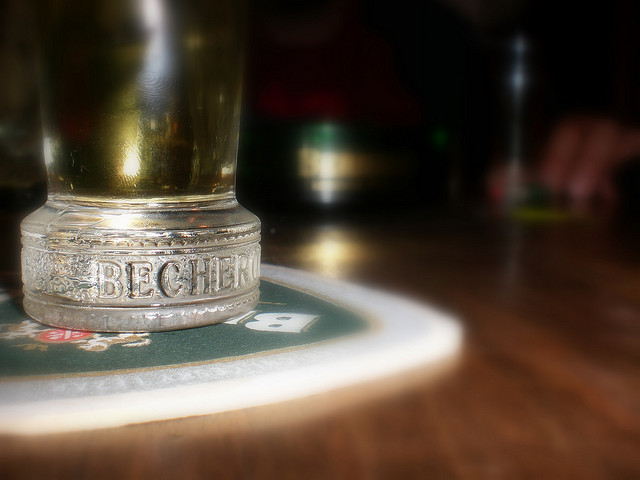
Becherovka is very popular among Czechs, but it is really an acquired taste. Photo © CT M, licensed Creative Commons Attribution No-Derivatives.
Everybody knows that a surefire way to make good with the locals is to imbibe the local brew. But what if it looks funny, smells weird, or you’ve heard it tastes like Grandma’s homemade cough syrup? Brace yourself by reading the following descriptions to both countries’ local liquors, then buck up and give them a try. If they’re not to your liking, take solace in the fact that you can always wash them down with some of the world’s finest wine and beer.The mysterious mind-altering effects of absinthe have made this spirit famous around the world. The origin of absinthe can be traced back to the end of the 18th century when French doctor Pierre Ordinaire began using wormwood (Artemisia absinthium) together with anise, fennel, hyssop, and numerous other herbs distilled in an alcoholic base as an herbal remedy for his patients. Absinthe is still banned in most countries today, but you’ll find it readily available in plenty of Prague bars, which play up the drink’s magical history. If you decide to give it a whirl, it will most likely be served to you in a small glass, along with a teaspoon and packet of sugar. Pour some sugar onto the spoon, then soak the spoonful with absinthe and light it in order to caramelize the sugar. When the flame goes out, stir the sugar into your drink, and drink it all down. You’ll soon realize why most bars have a two-absinthe maximum. And don’t worry—the “mind-altering effects” are largely exaggerations. Try some of the “Green Fairy” at Red Room, Harley’s Bar, and Batalion in Prague.
Becherovka is an interesting 100 percent natural alcoholic drink. The sweet herbal liquid has a maturation process before it is filtered and bottled, and the recipe hasn’t changed in over 200 years. Becherovka is very popular among Czechs, but it is really an acquired taste. Give it a try, but don’t feel bad if it’s not to your liking. You can find Becherovka pretty much anywhere, including J.J. Murphy’s, Fraktal, and M1 Secret Lounge.
Almost always drunk as a shot, pálinka is an integral part of Hungarian drinking culture. The word’s origin comes from the Slavic word páliť (distill). Made from plums, apples, pears, apricots, and sometimes cherries, a shot of this brandy was traditionally used as a digestion aid. Today, it can be found in most Budapest bars, including Szoda, 400, and Morrison’s Music Pub.
“Das ist ein Unikum!” (That is special/unique!) is the phrase most associated with this digestive liqueur that dates back to Kaiser Joseph II of Austria. Made from 40 different herbs and spices, it is one of Hungary’s most requested spirits. Don’t let its tar-black color and syrupy consistency scare you away; just prepare yourself for a considerably earthier version of Jägermeister with a bitter aftertaste. Try it at Szimpla kert and Corvintető, both in Budapest.
Popular with hipsters the world over, Fernet is an herbal liquor for anyone who likes the strong stuff. In Prague and Budapest, you can find two flavors: Fernet Stock (bitter) and Fernet Citrus (lemon flavored). The recipe is heavily guarded, and with ingredients such as gentian root, quinine, orange peels, and Roman chamomile, you probably are better off not knowing it. An Italian original, this spirit is best served cold or with ice, but it also makes for a potent shooter. Try a shot of Fernet in Prague along with your beer at Duende, Chapeau Rouge, and Blue Light.
Excerpted from the Third Edition of Moon Prague & Budapest.